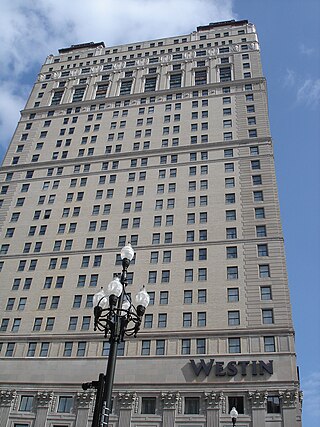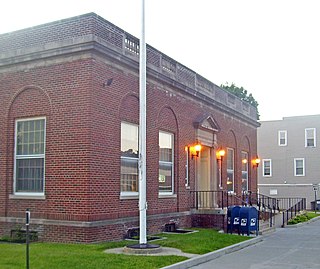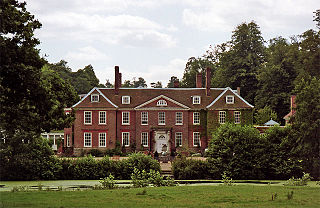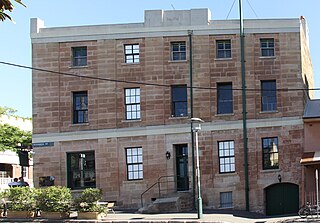
The Westin Book Cadillac Detroit is a historic skyscraper hotel in downtown Detroit, Michigan, within the Washington Boulevard Historic District. Designed in the Neo-Renaissance style, and opened as the Book-Cadillac Hotel in 1924, the 349 ft (106 m), 31-story, 453-room hotel includes 65 exclusive luxury condominiums and penthouses on the top eight floors. It reopened in October 2008, managed by Westin Hotels, after a $200-million restoration.

The Whitney Tavern Stand served as an inn and local gathering place in Cascade Township, Michigan for fifty years after its construction in the 1852-53 period. In its first few years it served as a stop for stagecoaches on the lines that, connecting Battle Creek, Hastings, and Kalamazoo with Grand Rapids, passed through Whitneyville. It is listed in the National Register of Historic Places.

The Cass Park Historic District is a historic district in Midtown Detroit, Michigan, consisting of 25 buildings along the streets of Temple, Ledyard, and 2nd, surrounding Cass Park. It was listed on the National Register of Historic Places in 2005 and designated a city of Detroit historic district in 2016.

The Monroe Avenue Commercial Buildings, also known as the Monroe Block, is a historic district located along a block-and-a-half stretch at 16-118 Monroe Avenue in Detroit, Michigan, just off Woodward Avenue at the northern end of Campus Martius. The district was designated a Michigan State Historic Site in 1974 and listed on the National Register of Historic Places in 1975. The thirteen original buildings were built between 1852 and 1911 and ranged from two to five stories in height. The National Theatre, built in 1911, is the oldest surviving theatre in Detroit, a part of the city's original theatre district of the late 19th century, and the sole surviving structure from the original Monroe Avenue Commercial Buildings historic period.

The Lancaster and Waumbek Apartments were small apartment buildings respectively located at 227-29 and 237-39 East Palmer Avenue in Detroit, Michigan. The apartments were listed on the National Register of Historic Places in 1997. They were demolished in November 2005.

The C. Burton Hotel, also known as the Sycamore House, is located on NY 55 a mile west of Grahamsville, New York, United States. It is a wooden Greek Revival structure dating to 1851.

The U.S. Post Office in Hoosick Falls, New York, is located on Main Street a block south of downtown. It is a brick building erected in the mid-1920s, serving the 12090 ZIP Code, which covers the village of Hoosick Falls and surrounding portions of the Town of Hoosick.

St. Mark's Episcopal Church is located on Main Street in Hoosick Falls, New York, United States. It is a mid-19th century brick building. The congregation itself was founded in the 1830s.

The Hoosick Falls Armory is located along Church Street in Hoosick Falls, New York, United States. It is a red brick building with castellated tower dating to the late 19th century.

The Ulster House Hotel, formerly the Wellington Hotel, is located on Main Street in Pine Hill, New York, United States. It is a large wooden Italianate-style building dating to the late 19th century, currently vacant and undergoing renovations.

The Williams–DuBois House is located at Grace Lane and Pinesbridge Road in New Castle, New York, United States. It was built by an early settler of the area during the Revolutionary War. In 1989 it was listed on the National Register of Historic Places.

The Bauer Manor, also known as the Davenport House or Davenport Hotel, is a hotel located at 1280 U.S. Route 12 near the unincorporated community of Tipton in Franklin Township in northern Lenawee County, Michigan. It was designated as a Michigan State Historic State on May 18, 1971 and listed on the National Register of Historic Places on May 4, 2007.

Chilston Park is a country house in Boughton Malherbe, Kent, England. Started in the 15th century, the house has been modified many times and is a Grade I listed building, currently operated as a country house hotel.

The Oil Capital Historic District (OCHD) is an area in downtown Tulsa, Oklahoma that commemorates the success of the oil business in Tulsa during the early 20th century. During this period, Tulsa was widely known as "The Oil Capital of the World." The area is bounded by 3rd Street on the north and 7th Street on the south, Cincinnati Avenue on the east and Cheyenne Avenue on the west.

Hyde's Hotel, also known as Hyde Manor, was a major summer resort hotel on Vermont Route 30 in Sudbury, Vermont. The remnants of the hotel, its main house built in 1865, are now deteriorating and partially collapsed. The property was listed on the National Register of Historic Places in 1980.

The Shipwrights Arms Inn is a heritage-listed residence and former inn and boarding house located at 75 Windmill Street, in the inner city Sydney suburb of Millers Point in the City of Sydney local government area of New South Wales, Australia. It was built from 1832 to 1834. It was added to the New South Wales State Heritage Register on 2 April 1999.
The Quincy Hotel is a historic commercial building at 57 Depot Street in the Enosburg Falls village of Enosburgh, Vermont. Built about 1876 in the Second Empire style, it was restyled after a fire in the early 20th century to its present Colonial Revival appearance to a design by Vermont architect Lewis Newton. It was listed on the National Register of Historic Places in 2019 for its architectural significance.

Sir Thomas Herbert's House, often known as Herbert House, is a Grade I listed building in York, dating from the 16th and 17th centuries.

Dutton Hotel, Stagecoach Station is located on Jolon Road in Jolon, California. What remains are ruins of an adobe inn that was established in 1849. The Dutton Hotel was a major stagecoach stop on El Camino Real in the late 1880s. The landmark was listed on the National Register of Historic Places on October 14, 1971.

The Desmet Avenue Warehouse Historic District is a 2 acres (0.81 ha) historic district in the Logan neighborhood just outside the city center of Spokane, Washington which was listed on the National Register of Historic Places in 1997. The listing includes six contributing properties, two of which have subsequently been demolished. The district was notable for its tight collection of early-20th century structures over just two city blocks that all served like purposes. Of the four remaining structures, only one is still used for a purpose similar to what it was built to serve. The two easternmost structures are now part of the Gonzaga University campus, which surrounds the eastern half of the district to the north, east and south.
























